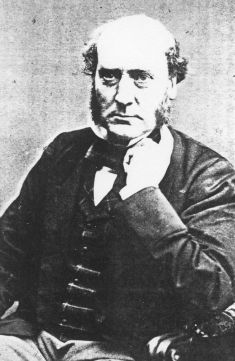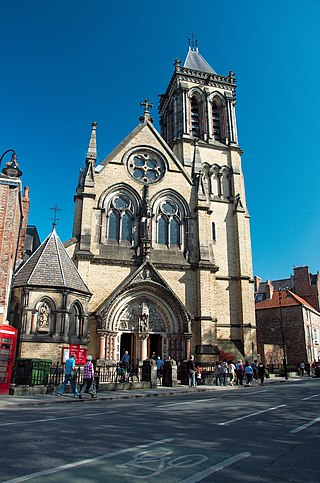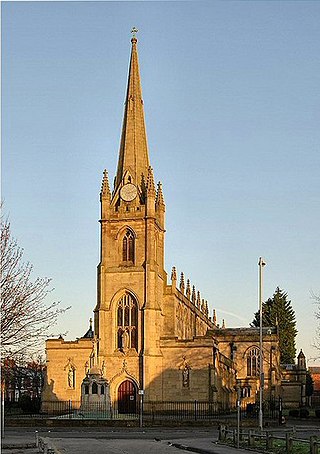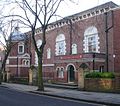
Sir George Gilbert Scott, largely known as Sir Gilbert Scott, was a prolific English Gothic Revival architect, chiefly associated with the design, building and renovation of churches and cathedrals, although he started his career as a leading designer of workhouses. Over 800 buildings were designed or altered by him.

The Archdiocese of Birmingham is one of the principal Latin Church diocese of the Catholic Church in England and Wales. The archdiocese covers an area of 3,373 square miles (8,740 km2), encompassing Staffordshire, the West Midlands, Warwickshire, Worcestershire and much of Oxfordshire as well as Caversham in Berkshire. The metropolitan see is in the City of Birmingham at the Metropolitan Cathedral Church of Saint Chad. The metropolitan province includes the suffragan dioceses of Clifton and Shrewsbury.

Charles Eamer Kempe was a British Victorian era designer and manufacturer of stained glass. His studios produced over 4,000 windows and also designs for altars and altar frontals, furniture and furnishings, lychgates and memorials that helped to define a later nineteenth-century Anglican style. The list of English cathedrals containing examples of his work includes: Chester, Gloucester, Hereford, Lichfield, Wells, Winchester and York. Kempe's networks of patrons and influence stretched from the Royal Family and the Church of England hierarchy to the literary and artistic beau monde.
Charles Francis Hansom was a prominent Roman Catholic Victorian architect who primarily designed in the Gothic Revival style.

George Goldie was an English ecclesiastical architect who specialised in Roman Catholic churches.

The Cathedral Church of St John the Evangelist is a Roman Catholic cathedral in Portsmouth, England. It is the mother church of the Portsmouth diocese and seat of the Bishop of Portsmouth, currently the Right Reverend Philip Egan. It was dedicated on 10 August 1882.
Henry Isaac Stevens FRIBA was an architect based in Derby. He was born in London, in 1806, and died in 1873. In the late 1850s he changed his name to Isaac Henry Stevens.

Cotton is a village and civil parish in Staffordshire, England. It is about 5 miles (8.0 km) north-east of Cheadle.

Hawkesyard Priory was a Dominican priory off Armitage Lane Brereton, Rugeley, Staffordshire, England, built between 1896 and 1914 which included the Roman Catholic Priory Church of St Thomas.

St Bartholomew's Church is in Penn, a district of Wolverhampton, West Midlands, England. It is an active Anglican parish church in the deanery of Trysull, the archdeaconry of Walsall, and the diocese of Lichfield. Its benefice is united with that of St Anne, Lower Penn. The church is recorded in the National Heritage List for England as a designated Grade II* listed building.

Our Lady of Loreto & St Winefride Catholic Church, Kew is the parish church for the Roman Catholic parish of Kew Gardens in the London Borough of Richmond upon Thames. The church is located at 1 Leyborne Park in Kew.

Saint Wilfrid's Church is a Roman Catholic church run by the Society of Jesus, in the city centre of Preston, Lancashire, England. It was built in 1793 and is situated between Fishergate and Winckley Square on Chapel Street.

The Syro-Malabar Cathedral of St Alphonsa is a Catholic cathedral of the Syro-Malabar rite in Preston, Lancashire. It is the cathedral of the Syro-Malabar Catholic Eparchy of Great Britain, and was previously St Ignatius Church under the Diocese of Lancaster. It is situated close to the Preston city centre, with the entrance on Meadow Street. The building was opened in 1836 and was the first church in Preston to have a spire.
Joseph John Scoles (1798–1863) was an English Gothic Revival architect, who designed many Roman Catholic churches.

St Francis of Assisi Church is a Roman Catholic Parish church in Birmingham. While the church is located between the Lozells and Hockley parts of the city, the parish covers most of Handsworth. It was founded in 1840, originally as a chapel in the nearby listed building, St. Mary's Convent designed by Augustus Pugin.

St Austin's Church is a Roman Catholic Church building in Wakefield, England. It is situated near where Northgate meets Marsh Way close to the city centre. It was founded in 1827 by the Society of Jesus and is a Grade II listed building.

St James the Less and St Helen Church is a Roman Catholic Parish church in Colchester, Essex, England. It was built in 1837 and designed by Joseph John Scoles. It is situated on Priory Street between the junction with East Hill and St Thomas More Catholic Primary School in the city centre. Next to it is the church hall which was built in 1911 and designed by Alexander Scoles.

St Peter and St Paul Church is a Roman Catholic Parish church in Wolverhampton, West Midlands, England. It was built from 1826 to 1828, with extensions being built in 1901 and 1928. It was designed by Joseph Ireland and the architect for the extension in 1901 was Edward Goldie. It is built as part of Giffard House, which is now a presbytery for the church. It is situated on Paternoster Row, between Wolverhampton City Council and the Ring Road St Peters. Both the church and Giffard House are a Grade II* listed building.

The Church of All Saints is a Roman Catholic parish church in Hassop, Derbyshire. Built in 1816–17, the architect was Joseph Ireland. It is a Grade I listed building.

Holy Ghost Church is a Roman Catholic church in Basingstoke, Hampshire, England. It was built from 1902 to 1903 by the priest and architect Alexander Scoles in the Gothic Revival style. It was named after the old ruined medieval Chapel of the Holy Ghost in the town. It is located on the corner of Chapel Hill and Sherborne Road, north of Basingstoke railway station near the town centre. According to Historic England, the church was "the last and best work" of Alexander Scoles. He is buried there and it is a Grade II listed building.





















